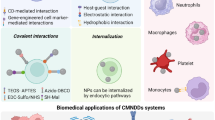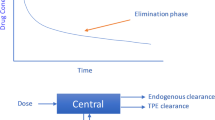Abstract
In the frame of this work, cellulose microbeads with an average particle size of 2.3 μm were characterized with respect to porosity using a batch solute exclusion method and two groups of model substances, namely proteins and polystyrene sulfonates. The pores of the microbeads were almost completely accessible to proteins with Stokes radii below 2.5 nm. More than 60% of the pores were accessible to albumin, which is relevant for the application in blood purification, since many target substances are albumin bound. Activation of the microbeads with increasing amounts of sodium metaperiodate yielded matrices with dialdehyde contents between 100 and 1,000 μmol/g. The activated beads were well suited for the covalent attachment of functional ligands, such as antibodies. Immobilization of antibodies against the pro-inflammatory cytokine TNF-α resulted in efficient TNF-α adsorbents which possess application potential in extracorporeal blood purification, e.g. for the modulation of cytokine levels as supportive therapy for sepsis and other inflammatory disorders.




Similar content being viewed by others
References
Ash SR, Blake DE, Carr DJ, Carter C, Howard T, Makowka L (1992) Clinical effects of a sorbent suspension dialysis system in the treatment of hepatic coma (the BioLogic DT). Int J Artif Organs 15:151–161
Boeden HF, Pommerening K, Becker M, Rupprich C, Holtzhauer M, Loth F, Müller R, Bertram D (1991) Bead cellulose derivates as supports for immobilization and chromatographic purification of proteins. J Chromatogr 552:389–414
De Oliveira W, Glasser WG (1996) Hydrogels from polysaccharides. I. Cellulose beads for chromatographic support. J Appl Polymer Sci 60:63–73
Falkenhagen D, Weber C, Schima H, Loth F, Rajnoch C, Vogt G, Moser H, Mitzner S (1994) Eine neue Technologie der simultanen filtration/adsorption auf der Basis einer high-speed-Rezirkulation von nano- und microspheres für die extrakorporale Blutreinigung. Biomedizinische Technik 39:105–108
Falkenhagen D, Schima H, Loth F Arrangement for removing substances from liquids, in particular blood. Patent WO9504559; Japanese patent # 50 1083 (1997); United States patent #5,855,782 (1999)
Falkenhagen D, Strobl W, Vogt G, Schrefl A, Linsberger I, Gerner FJ, Schoenhofen M (1999) Fractionated plasma separation and adsorption system—a novel system for blood purification to remove albumin bound substances. Int J Artif Organs 23:81–86
Fasman GD (1976) Handbook of biochemistry and molecular biology, section A: proteins, 3rd edn. CRC press, Cleveland
Grznárová G, Yu S, Štefuca V, Polakovic M (2005) Quantitative characterization of pore structure of cellulose gels with or without bound protein ligand. J Chromatogr A 1092:107–113
Huxley VH, Curry FE, Adamson RH (1987) Quantitative fluorescence microscopy on single capillaries: alpha-lactalbumin transport. Am J Physiol Heart Circ Physiol 252:188–197
Ikeda S et al (2000) Intermolecular forces in bovine serum albumin solutions exhibiting solidlike mechanical behaviors. Biomacromolecules 1:757–763
Kaster JA, de Oliveira W, Glasser WG, Velander WH (1993) Optimization of pressure-flow limits, strength, intraparticle transport and dynamic capacity by hydrogel solids content and bead size in cellulose immunosorbents. J Chromatogr 648:79–90
Kim UJ, Kuga S (2000) Reactive interaction of aromatic amines with dialdehyde cellulose gel. Cellulose 7:287–297
Kuga S (1980) New cellulose gel for chromatography. J Chromatogr 195:221–230
Mosbach KH, Nilsson K (1983) Method of covalent binding biologically active organic substances to polymer substance. US patent 4,415,665
Okafor C, Ward DM, Mokrzycki MH, Weinstein R, Clark P, Balogun RA (2010) Introduction and overview of therapeutic apheresis. J Clin Apher 25:240–249
Peška J, Štamberg J, Hradil J, Ilavsky M (1976) Cellulose in bead form. Properties related to chromatographic uses. J Chromatogr 125:455–469
Potschka M (1987) Universal calibration of gel permeation chromatography and determination of molecular shape in solution. Anal Biochem 162:47–64
Stegmayr BG (2005) A survey of blood purification techniques. Transfus Apher Sci 32:209–220
Thümmler K, Fischer S, Feldner A, Weber V, Ettenauer M, Loth F, Falkenhagen D (2011) Preparation and characterization of cellulose microspheres. Cellulose 18:135–142
Volkert B, Wolf B, Fischer S, Li N, Lou C (2009) Applications of modified bead cellulose as a carrier of active ingredients. Macromolec Symp 280:130–135
Wagenknecht W, Fanter C, Loth F (1996) Process for producing spherical microparticles on the basis of cellulose acetate. European patent EP0750007
Weber V, Linsberger I, Ettenauer M, Loth F, Höyhtya M, Falkenhagen D (2005) Development of specific adsorbents for human tumor necrosis factor-α (TNF-α): influence of antibody immobilization on performance and biocompatibility. Biomacromolecules 6:1867–1870
Weber V, Hartmann J, Linsberger I, Falkenhagen D (2007) Efficient adsorption of tumor necrosis factor with an in vitro set-up of the microspheres-based detoxification system. Blood Purif 25(2):169–174
Weber V, Ettenauer M, Linsberger I, Loth F, Thümmler K, Feldner A, Fischer S, Falkenhagen D (2010) Functionalization and application of cellulose microparticles as adsorbents in extracorporeal blood purification. Macromol Symp 294:90–95
Wolf B (1998) Hydrophilic-lipophilic drug carrier systems of bead cellulose and isopropyl myristate. Drug Dev Ind Pharm 24:1007–1015
Wolf B, Horsch W (1991) Herstellung, Eigenschaften und Verwendung der Perlcellulose—eine Übersicht. Pharmazie 46:392–402
Acknowledgments
This work was supported by the Federal Government of Lower Austria (Technopol Programme) with co-financing by the European Commission (article 4, EFRE). The excellent technical assistance of Ingrid Linsberger is gratefully acknowledged.
Author information
Authors and Affiliations
Corresponding author
Rights and permissions
About this article
Cite this article
Ettenauer, M., Loth, F., Thümmler, K. et al. Characterization and functionalization of cellulose microbeads for extracorporeal blood purification. Cellulose 18, 1257–1263 (2011). https://doi.org/10.1007/s10570-011-9567-2
Received:
Accepted:
Published:
Issue Date:
DOI: https://doi.org/10.1007/s10570-011-9567-2




